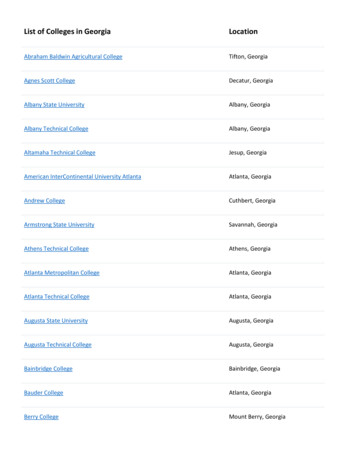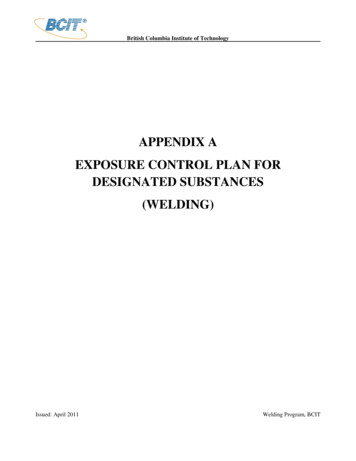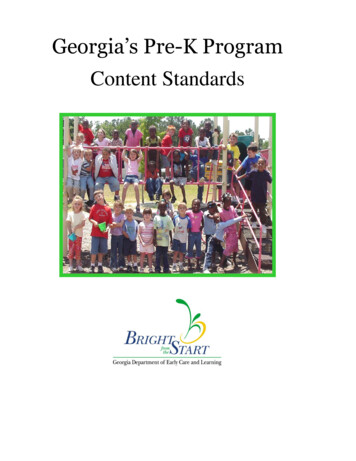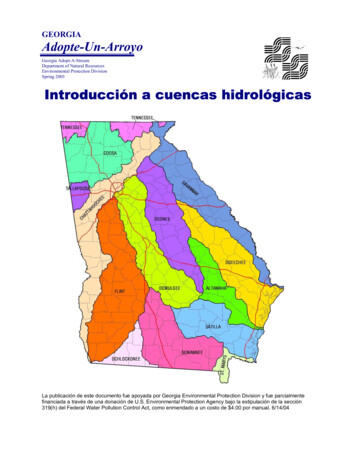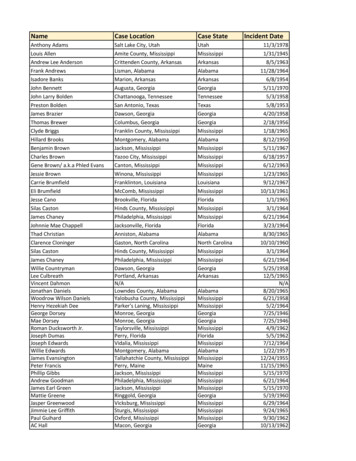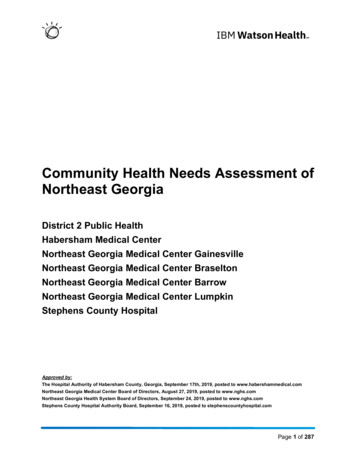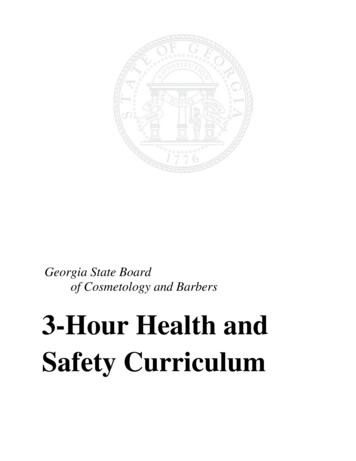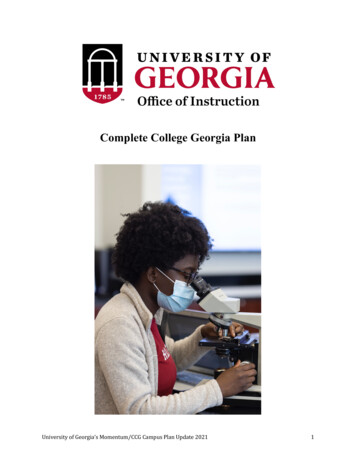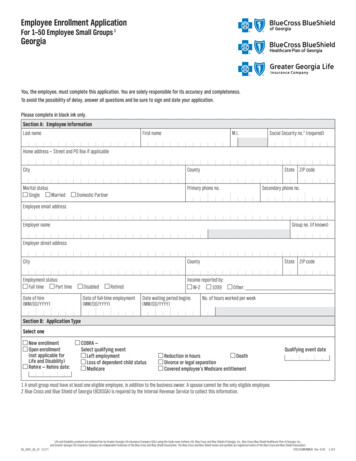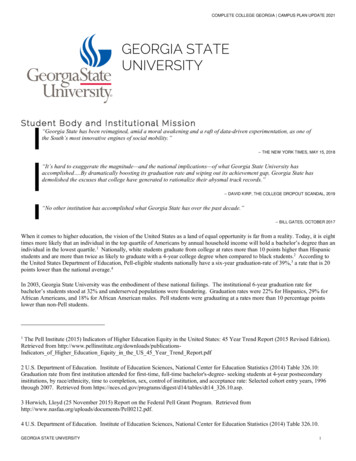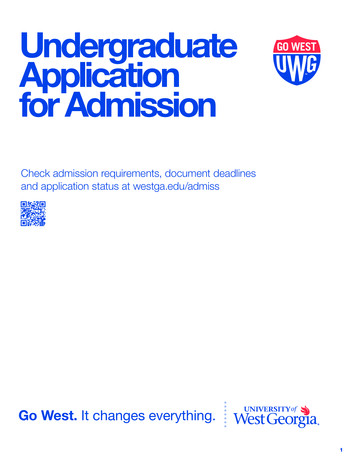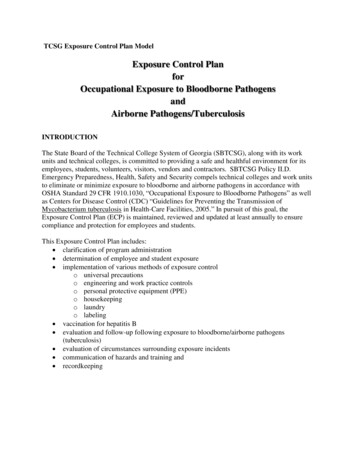
Transcription
TCSG Exposure Control Plan ModelExposure Control PlanforOccupational Exposure to Bloodborne PathogensandAirborne Pathogens/TuberculosisINTRODUCTIONThe State Board of the Technical College System of Georgia (SBTCSG), along with its workunits and technical colleges, is committed to providing a safe and healthful environment for itsemployees, students, volunteers, visitors, vendors and contractors. SBTCSG Policy II.D.Emergency Preparedness, Health, Safety and Security compels technical colleges and work unitsto eliminate or minimize exposure to bloodborne and airborne pathogens in accordance withOSHA Standard 29 CFR 1910.1030, “Occupational Exposure to Bloodborne Pathogens” as wellas Centers for Disease Control (CDC) “Guidelines for Preventing the Transmission ofMycobacterium tuberculosis in Health-Care Facilities, 2005.” In pursuit of this goal, theExposure Control Plan (ECP) is maintained, reviewed and updated at least annually to ensurecompliance and protection for employees and students.This Exposure Control Plan includes: clarification of program administration determination of employee and student exposure implementation of various methods of exposure controlo universal precautionso engineering and work practice controlso personal protective equipment (PPE)o housekeepingo laundryo labeling vaccination for hepatitis B evaluation and follow-up following exposure to bloodborne/airborne pathogens(tuberculosis) evaluation of circumstances surrounding exposure incidents communication of hazards and training and recordkeeping
I.PROGRAM ADMINISTRATIONA. Glenn R. Henry serves as the Exposure Control Coordinator (ECC) and is responsible for theimplementation, maintenance, review, and updating of the Exposure Control Plan (ECP).The ECC will be responsible for ensuring that all required medical actions are performed andthat appropriate health and records are maintained. Further, the ECC will be responsible fortraining, documentation of training as well as making the written ECP available toemployees, students, and any compliance representatives.Contact Information for Exposure Control Coordinator:Glenn R. Henry706-355-5033ghenry@athenstech.eduB. Those employees and students who are determined to be at risk for occupational exposure toblood, other potentially infectious materials (OPIM) as well as at risk for exposure toairborne pathogens/tuberculosis must comply with the procedures and work practicesoutlined in this ECP.C. Athens Technical College will provide and maintain all necessary personal protectiveequipment (PPE), engineering controls (e.g., sharps containers), labels and containers asrequired. Further, adequate supplies of the aforementioned equipment will be available inthe appropriate sizes/fit.Contact Information for Responsible Person(s) or Department(s):Glenn R. Henry 706-355-5033 Dean, Life ScienceJeff Strickland 706-355-5039 Director of Safety & SecurityII. EXPOSURE DETERMINATIONEmployees and/or students are identified as having occupational exposure tobloodborne/airborne pathogens based on the tasks or activities in which they engage. Thesetasks or activities are placed into categories as defined by the 1987 joint advisory notice by theU.S. Department of Labor and the U.S. Department of Health and Human Services. The relativerisk posed by these tasks or activities, as well as the measures taken to reduce or eliminate risk ofoccupational exposure are also determined by the category.Category I: A task or activity in which direct contact or exposure to blood, other potentiallyinfectious materials, or airborne pathogens (tuberculosis) is expected and to which universalprecautions apply.Category II: A task or activity performed without exposure to blood or other potentiallyinfectious materials, or airborne pathogens (tuberculosis) and to which universal precautionsapply, but exposure to another person’s blood or to OPIM might occur as an abnormal event oran emergency or may be required to perform unplanned Category I tasks or activities.
Category III: A task or activity that does not entail normal or abnormal exposure to blood orother potentially infectious materials, or airborne pathogens (tuberculosis) and to which universalprecautions do not apply.Employees or students who engage in tasks or activities which are designated as Category I or II,as well as their occupational area, are considered to be “covered” by the parameters of the ECP,including part-time, temporary, contract and per-diem employees.The following is a list of job and/or student program classifications which have Category I or IIoccupational exposure. Included is a list of the tasks or activities or groups of closely relatedtasks or activities in which occupational exposure may occur for these individuals.Example: (Expand as necessary to describe those employees and students who are potentially atrisk for occupational exposure.)CATEGORY I TASKS“A task or activity in which direct contact or exposure to blood, other body materials, or air bornepathogens to which Universal Precautions/Standard precautions apply is normal.”CATEGORY I TASK LISTINGCategory I tasks performed in classroom, laboratory and clinical activities for each occupational trainingprogram/course are to be listed below:Category I tasks performed in classroom, laboratory and clinical activities for each occupational trainingprogram/course are to be listed below:CERTIFIED NURSING ASSISTANTPerform postmortem careVital signs, oral and rectal tempsCollecting and handling of body fluid specimensEmergency resuscitation/CPRHandling and cleaning of body fluid spillsNursing care of infectious/isolated patientsEARLY CHILDHOOD CARE AND EDUCATIONCleaning of spills of body fluidsWound care: examination, cleaning, bandagingResuscitation/CPRBathing/skin care of non-intact skinHair and skin care of children with non-intact skinDENTAL ASSISTINGInfection controlOral evacuationIsolation-placement and removal of cotton rollsApplication and removal of matrix bandsPreparation and seating of temporary crowns and bridgesAssisting with placement and /or removal of temporary cement
Assisting with endodontic proceduresAssisting with periodontal proceduresAssisting with maxillofacial and oral specialty proceduresRespond to and assist in the management of chair-side emergenciesAssisting with general dentistry proceduresExposing radiographsAssisting with pediatric and orthodontic proceduresAssisting with and/or polishing teethAssisting with administration of anesthesiaDENTAL HYGIENEExtra and Intra oral examProbingInstrumentationPolishingPrepare for sterilizationUltra-sonic instruments cavipo/densonicIrrigationLocal anesthetic procedures, gauze, handling needles, cartridges/disposalSealantsInstrument sharpening during procedureExposing radiographs on patientsEMERGENCY MEDICAL TECHNOLOGY / EMTWound care: irrigation, packing, bandaging, examinationOral and tracheal suctioningFracture careBleeding control, managing frank bloodAirway and ventilation careNaso, oral, and gastric intubationDelivery of infant, postpartum careCollection of body fluids specimensCare of newborn/cord careHandling of contaminated linens and equipmentAssisting with biopsy, spinal tap, thoracentesis or other invasive proceduresFoley catheter insertion and careDressing careBlood Glucose monitoring (Glucometer)MEDICAL ASSISTINGOral and rectal temperaturesHandling and cleaning contaminated instruments and equipmentAssisting with minor surgical proceduresCollection of blood and urine specimensVenipuncture, management of sharpsTesting of body fluids using dipsticks, tapes, tablets, specific gravityMicroscopic procedures, analysis of body fluid specimensPrepare smears and gram-stain of slidesThroat culturesAdminister intramuscular, intradermal, and subcutaneous injectionsBlood Glucose monitoring (Glucometer)
PARAMEDIC TECHNOLOGYOral and Tracheal suctioningHandling and cleaning contaminated linens and equipmentDressing changes and wound care, irrigation, packing, bandaging, examinationControl of bleeding, management of frank bloodResuscitation/CPRIntubation, oral, nasal, gastricManagement of multi-trauma patientsCollection and handling of body fluid specimensVenipuncture, starting and maintaining IV’sAdministering blood and blood productsAssisting with biopsy, spinal tap, thoracentesis, or other invasive procedureEmergency delivery of infant/postpartum careCare of newborn infant/cord careRectal and/or oral temperaturesFracture careInsertion of urinary cathetersTracheostomy careAirway and ventilation careIntraosseous, intramuscular, intravenous, subcutaneous injections/medicationsadministrationAdministration of medications via other routes: optic, otic, rectal, oral, vaginalCrycothyroidotomyPleural decompressionBlood glucosePRACTICAL NURSINGAdministration of medications involving exposure to blood, body fluids, and/or exposureto sharps: intravenous, intramuscular, subcutaneous, intradermal, oral, optic, rectal,vaginalWound care, examination, irrigation, packing, dressing changesEmptying drainage contains: catheters, hemovac, Jackson-Pratt, containing body fluidsSuture/clip removalTracheotomy care and suctioningNasopharyngeal suctioningAssisting with lumbar punctures, amniocentesis, thoracentesis, other procedures forthe collection of body fluidsAssist with chest tube insertion and removalAdministration of enemas and douchesPerform postmortem careVital signs, oral and rectal tempsPostpartum and newborn care/cord careCollecting and handling of body fluid specimensCollection of cultures specimensAssisting and administering blood and blood productsSelected IV procedures as defined by the clinical facility, may include Venipuncture, IVdressing changes, DC of INTEmergency resuscitation/CPRHandling of sharpsHandling and cleaning of body fluid spillsHandling contaminated linens and equipmentNursing care of infectious/isolated patientsBlood glucose monitoring (Glucometer)
SURGICAL TECHNOLOGYAssisting anesthesia or recovery room personnel with suctioning andincubation/extubationScrub duties on all surgical proceduresCirculating duties on all surgical proceduresCare of newbornTransfusion therapyCollecting and processing specimens (blood and tissue)ResuscitationHandling linens and articles soiled with bloodO.R. housekeeping dutiesCare and maintenance of wound drainage devicesTrauma careDecontamination of soiled surgical instrumentsUrethral CathertizationAssistance during: thoracentesis, vaginal exams, intracranial monitoring procedures,lumbar punctures, bone marrow aspiration, organ procurement, joint aspiration,endoscopyDecontamination of equipmentNURSINGAdministration of medications involving exposure to blood, body fluids, and/or exposureto sharps: intravenous, intramuscular, subcutaneous, intradermal, oral, optic, rectal,vaginalWound care, examination, irrigation, packing, dressing changesEmptying drainage contains: catheters, hemovac, Jackson-Pratt, containing body fluidsSuture/clip removalTracheotomy care and suctioningNasopharyngeal suctioningAssisting with lumbar punctures, amniocentesis, thoracentesis, other procedures forthe collection of body fluidsAssist with chest tube insertion and removalAdministration of enemas and douchesPerform postmortem careVital signs, oral and rectal tempsPostpartum and newborn care/cord careCollecting and handling of body fluid specimensCollection of cultures specimensAssisting and administering blood and blood productsSelected IV procedures as defined by the clinical facility, may include venipuncture, IVdressing changes, DC of INTEmergency resuscitation/CPRHandling of sharpsHandling and cleaning of body fluid spillsHandling contaminated linens and equipmentNursing care of infectious/isolated patientsBlood glucose monitoring (Glucometer)RADIOGRAPHYAssisting with venipuncture/I.V. contrast administrationRadiography of a trauma patientRadiography of a patient with acute G.I. bleedHandling of linens or equipment soiled with blood or body fluidsHandling of soiled immobilization devices and dressingsAssisting in surgical procedures requiring mobile radiography or C-arm fluoroscopy
Radiography of biopsy specimenAssisting with fluoroscopic or C.T. guided biopsy proceduresAssisting with lumbar puncture/fluid collection during myelographyAssisting with arthrographyAssisting with angiographyPHELEBOTOMYPerform venipuncture with both syringes and evacuator tubePerform skin punctureCPRHandling linens soiled with bodily fluidsCATEGORY I TASK STANDARD OPERATING GUIDELINESDEFINITION:A Category I Task is one in which there is a normal occurrence for exposure to blood, other potentiallyinfectious body materials or air borne pathogens that warrant the use of exposure controls.FACULTY POSITIONS INVOLVED:The technical college faculty positions involved in the performance of Category I tasks are:Certified Nursing Assistant instructorChild Care Instructor and part-time instructorsDental Assisting InstructorDental Hygiene Instructors and adjunctsEMT Instructors and adjunctsMedical Assisting Instructors and Medical Lab AssistantsParamedic Instructor and adjunctsPhysical Therapist Assistant Instructor and adjunctsPractical Nursing Instructor and adjunctsSurgical Technology Instructors and adjunctNursing Instructors and adjunctsPhelebotomy Instructors and adjunctsRadiography Instructors and adjuncts
STUDENT OCCUPATIONAL TRAINING PROGRAMS/COURSES INVOLVED:The technical college student occupational programs or courses involved in the performance of CategoryI tasks are:Certified Nursing AssistantEarly Childhood Care and EducationDental AssistantDental HygienistEMTMedical AssistantParamedicPhysical Therapist AssistantPractical NurseSurgical TechnologyNursingPhlebotomyRadiographyCATEGORY II TASK LISTINGCategory II tasks performed in classroom, laboratory and clinical areas for each occupational trainingprogram/course are to be listed below:CERTIFIED NURSING ASSISTANTGeneral patient care and patients not requiring invasive proceduresVital signsBed bathsAmbulating patientsFeeding patientsSurgical/procedural observationsEARLY CHILDHOOD CARE AND EDUCATIONIf a child bites another child or teacherAccidents that involve bloodMouth careHandling contaminated linensChanging diapersHandling tears, comforting crying children
COSMETOLOGYHaircutting with scissors, razors, or clippers, whereby the patron or student is cutChemical reactions on patrons or students involving permanent waving, chemical hairrelaxers, color services, bleachingExposure to non-intact skin or skin disorders and diseases during facial treatments, scalptreatments, and/or hair removalManicuring/Pedicuring, student or patron contact: artificial nails, filing, cuticletreatment, glue reactionThermal styling, student or patron contact, burnsDENTAL ASSISTINGProcessing dental filmsAssisting with and/or applying topical fluoridePerforming vital signsPreparation of dental materialsSelecting and preparing tray set-upsObservation of dental materialsProviding preventative oral care information instructions to the patientDENTAL HYGIENEClean-up, disinfection, and disposal in clinicProcessing radiographsSet-up ultrasonic, etc, and clean-upCleaning dentures/RPD’sBiohazard waste disposalX-ray procedureFluoride treatmentEMERGENCY MEDICAL TECHNOLOGY/EMTPatient assessments, including vital signsGeneral patient care with patients not requiring invasive proceduresGeneral patient observationsMEDICAL ASSISTINGObtaining vital signsGeneral patient care with patients not requiring specimen collection or invasive proceduresGeneral patient observationPARAMEDIC TECHNOLOGYObtaining vital signsGeneral patient care and observationPRACTICAL NURSINGGeneral patient care and patients not requiring invasive proceduresVital signsBed bathsAmbulating patientsFeeding patientsSurgical/procedural observationsPhysical examinations and assessments
SURGICAL TECHNOLOGYPatient transportation and transferPatient pre-op interviewsAssistance with combative patient during anesthetic inductionHandling soiled patient equipment (not designated category I)Instrument processing in Central Supply (after decontamination)Pre and Postoperative patient care: positioning, vital signs, I & O Institution labsimulation (practicing use of sharps)NURSINGGeneral patient care and patients not requiring invasive proceduresVital signsBed bathsAmbulating patientsFeeding patientsSurgical/procedural observationsPhysical examinations and assessmentsPHYSICAL THERAYPatient transportationDressing and undressing of patientsAmbulation and gait trainingPatient treatmentRoutine assessmentsVital signsPatient positioningHandling of soiled equipmentRADIOGRAPHYTaking routine x-rays and diagnostic testsMonitoring invasive medical equipment attached to patientTransportation and transfer of patientsInsertion of enema tipAssisting a patient who is vomitingRoutine housekeeping dutiesCATEGORY II TASK STANDARD OPERATING GUIDELINESDEFINITION:A Category II Task is one in which there is a potential for, although not planned, contact with blood otherpotentially infectious materials or air borne pathogens.FACULTY POSITIONS INVOLVED:The faculty positions involved in the performance of Category II tasks are:The faculty positions involved in the performance of Category II tasks are:Certified Nursing Assistant instructor
Child Care Instructor and adjunctsCosmetology Instructors and adjunctsDental Assisting Instructor Dental Assisting Lab assistantsDental Hygiene Instructors and adjunct sEMT Instructors and adjunctsMedical Assisting Instructors and Medical Assisting Lab assistantsParamedic Instructor and adjunctsPractical Nursing Instructors and adjunctsSurgical Technology Instructor and adjunctsNursing Instructors and adjunct facultyRadiography instructors and facultyPhlebotomy instructors and adjunctsVeterinary Technology instructors and adjunctsPhysical Therapy instructors and adjunctsSTUDENT OCCUPATIONAL AREAS INVOLVED:The technical college student occupational programs or courses involved in the performance of CategoryII tasks are:Certified Nursing AssistantEarly Childhood Care and EducationCosmetologyDental AssistingDental HygieneEMTMedical AssistantParamedicPractical NurseSurgical Technology
NursingRadiographyPhelebotmoyPhysical TherapyVeterinary Technology
CATEGORY III TASK STANDARD OPERATING GUIDELINEDEFINITION:A Category III Task is one in which there is no potential for exposure to blood, other potentially infectiousbody materials or air borne pathogens that warrant the use of exposure controls.No special precautions are required when performing Category III tasks.FACULTY POSITIONS INVOLVED:The technical college faculty positions involved in the performance of Category III tasks are:CATEGORY III TASK LISTINGAcademic ProgramsBusiness & Public ServiceAccountingBusiness Administrative Office TechnologyBusiness AdministrationComputer Information SystemsCriminal JusticeCulinary ArtsEarly Childhood Care and EducationHotel, Restaurant, and Tourism ManagementMarketing ManagementParalegal StudiesSocial Work AssistantHealth Information TechnologyGeneral EducationDean - Dr. Carol Myers
Life SciencesBiotechnologyDental AssistingDental HygieneParamedicEmergency Medical TechnicianFire ScienceMedical AssistingNursing – Associate DegreePhysical TherapistPractical NursingRadiographySurgical TechnologyVeterinary TechnologyHealth Care Assistant, Patient Care Assisting & Phlebotomy TCCsAnatomy & Physiology.Technical & IndustrialAir Conditioning TechnologyAutomotive Collision RepairAutomotive TechnologyCommercial Truck DrivingCosmetologyDiesel MechanicsDrafting TechnologyElectrical Construction and MaintenanceElectronics TechnologyEngineering TechnologyIndustrial Systems TechnologyInterior DesignMachine Tool TechnologyWeldingThe technical college faculty positions involved in the performance of Category III tasks are:1)2)3)4)5)6)All employees listed under categories I and ll.AdministrationFacultySupport Staff / Secretarial/MaintenanceAll employees not designated under categories l and ll
The student occupational training program/course involved in the performance of Category III tasks onlyare:1) All students involved in standard classroom and Laboratory activities.2) All other areas not designated under categories l and llIII. IMPLEMENTATION OF METHODS OF EXPOSURE CONTROLA. Standard Precautions: All covered employees and students will use standard precautionsas indicated by the task or activity.B. Exposure Control Plan:1. All covered employees and students will receive an explanation of this ECP during theirinitial training or academic experience, as well as a review on an annual basis. Allcovered employees and students can review this ECP at any time while performing thesetasks or activities by viewing the plan on the Athens technical college intranet. Ifrequested, a hard copy of this ECP will be provided free of charge within 15 businessdays of request.2. The ECC will review and update the ECP annually, or more frequently if necessary toreflect any new or modified tasks or activities that affect occupational exposure and toreflect new or revised employee classifications or academic programs with potential foroccupational exposure.C. Engineering and Work Practice Controls:1. Engineering and work practice controls are developed and implemented to reduce oreliminate occupational exposure. Specific engineering and work practice controls forspecified tasks or activities are to be followed for each specific program. Each programwill have an infection control policy in their program handbook which outlines specificcontrols to be used.2. Protocol and documentation of the inspection, maintenance and replacement of sharpsdisposal containers is the responsibility of the Program Chairs for each individualprogram as they are familiar with the needed personal protection equipment needed foreach task.3. The processes for assessing the need for revising engineering and work practice controls,procedures, or products, and the individuals/groups involved are detailed below:Example:Academic Program Advisory Groups examine exposure control methods during advisory groupmeetings, and the recommendations are discussed with the ECC by the academic programmanager(s).D. Personal Protective Equipment:1. Appropriate personal protective equipment (PPE) is provided to covered employees at nocost and available to covered students at the student’s expense. Training in the use ofPPE for specific tasks is provided by Athens Technical College. These items are located
in each classroom or laboratory as appropriate and available at each clinical site.2. All covered employees and students using PPE must observe the following precautions:a. Wash hands immediately or as soon as feasible after removing gloves or other PPE.b. Remove PPE after it becomes contaminated and before leaving the work area.c. Used PPE may be disposed of in appropriate biohazard containers or sharpscontainers located in each area.d. Wear appropriate gloves when it is reasonably anticipated that there may be handcontact with blood or OPIM, and when handling or touching contaminated items orsurfaces; replace gloves if torn, punctured or contaminated, or if their ability tofunction as a barrier is compromised.e. Utility gloves may be decontaminated for reuse if their integrity is not compromised.Utility gloves should be discarded if they show signs of cracking, peeling, tearing,puncturing, or deterioration.f. Never wash or decontaminate disposable gloves for reuse.g. Wear appropriate face and eye protection when splashes, sprays, spatters, or dropletsof blood or OPIM pose a hazard to the eye, nose, or mouth.h. Remove immediately, or as soon as feasible, any garment contaminated by blood orOPIM, in such a way as to avoid contact with the outer surface.3. The protocol for handling used PPE is as follows: Dispose of PPE in the proper biohazardcontainers or red biohazard bags. Sharps must be disposed of in the approved sharpscontainers and shall not be placed into red bags or the trash. Students at clinical willfollow the clinical sites policies and procedures for disposal of soiled PPE.E. Housekeeping:1. Regulated waste is placed in containers which are closable, constructed to contain allcontents and prevent leakage, appropriately labeled or color-coded, and closed prior toremoval to prevent spillage or protrusion of contents during handling.2. The protocol for handling sharps disposal containers is: when containers are full to placethem in the biohazard waste room for pickup be the waste disposal company that hasbeen contracted by the College.3. The protocol for handling other regulated waste is: place into a red biohazard bag andplace it into the red biohazard trash receptacle for disposal.4. Contaminated sharps are discarded immediately or as soon as possible in containers thatare closable, puncture-resistant, leak proof on sides and bottoms, and appropriatelylabeled or color-coded. Sharps disposal containers are available each laboratory that is inuse on the college campus.5. Bins and pails (e.g., wash or emesis basins) are cleaned and decontaminated as soon asfeasible after visible contamination.6. Broken glassware that may be contaminated is only picked up using mechanical means,such as a brush and dustpan.F. Laundry:1. The following contaminated articles will be laundered in the life science buildingslaundry facility and by program faculty designated by the program chair for each healthprogram.
2. The following laundering requirements must be met articles that are laundered will bewashed on the sanitary cycle using the hot water mode. De-oxygenated bleach will beused in the wash cycle.a. Handle contaminated laundry as little as possible, with minimal agitation.b. Place wet contaminated laundry in leak-proof, labeled or color-coded containersbefore transport. Use (specify either red bags or bags marked with the biohazardsymbol) for this purpose.c. Wear the following PPE when handling and/or sorting contaminated laundry: Gloves,mouth and eye protection as appropriate.G. Labeling:1. The following labeling methods are used in this facility: Biohazard signs, biohazardwaste receptacles, and sharp containers.2. Safety and Security Department is responsible for ensuring that warning labels areaffixed or red bags are used as required if regulated waste or contaminated equipment isbrought into the facility. Employees and students are to notify safety and security if theydiscover regulated waste containers, refrigerators containing blood or OPIM,contaminated equipment, etc., without proper labels.IV. VACCINATION FOR HEPATITIS BA. The Dean of Life Science will provide training to covered employees on hepatitis Bvaccinations, addressing safety, benefits, efficacy, methods of administration, andavailability. Program Chairs will provide the same training to covered students.B. The hepatitis B vaccination series is available at no cost after initial covered employeetraining and within 10 days of initial assignment to all covered employees identified in theexposure determination section of this plan. The hepatitis B vaccination series is available tocovered students at cost after initial covered student training and within 10 days of initialassignment to all covered students identified in the exposure determination section of thisplan.C. Vaccination is encouraged unless: 1) documentation exists that the covered employee orcovered student has previously received the series; 2) antibody testing reveals that theemployee is immune; or 3) medical evaluation shows that vaccination is contraindicated.However, if a covered employee or student declines the vaccination, the covered employee orstudent must sign a declination form. Covered employees or students who decline mayrequest and obtain the vaccination at a later date at no cost to covered employees or at cost tocovered students. Documentation of refusal of the vaccination is kept at on file in HumanResources.D. Vaccination will be provided by Regional First Care at Hwy 29 location. The businessoffice is contacted for information before vaccinations can occur.E. Following the medical evaluation, a copy of the health care professional’s written opinionwill be obtained and provided to the covered employee or student within 15 days of the
completion of the evaluation. It will be limited to whether the covered employee or studentrequires the hepatitis B vaccine and whether the vaccine was administered.V. POST-EXPOSURE FOLLOW-UPA. Should an exposure incident occur, contact Glenn Henry at the following telephone number706-355-5033.B. An immediately available confidential medical evaluation and follow-up will be conductedby Regional First Care (if needed). Following initial first aid (clean the wound, flush eyesor other mucous membrane, etc.), the following activities will be performed:1. Document the routes of exposure and how the exposure occurred via the infectionexposure reporting form found on the colleges intranet.2. Identify and document the source individual (unless the employer can establish thatidentification is infeasible or prohibited by state or local law).3. For blood or OPIM exposure:a. Obtain consent and make arrangements to have the source individual tested as soon aspossible to determine HIV, HCV, and HBV infectivity; document that the sourceindividual’s test results were conveyed to the employee’s/student’s health careprovider.b. If the source individual is already known to be HIV, HCV and/or HBV positive, newtesting need not be performed.c. Exposure involving a known HIV positive source should be considered a medicalemergency and post-exposure prophylaxis (PEP) should be initiated within 2 hours ofexposure, per CDC recommendations.d. Assure that the exposed employee/student is provided with the source individual’stest results and with information about applicable disclosure laws and regulationsconcerning the identity and infectious status o
The technical college faculty positions involved in the performance of Category I tasks are: Certified Nursing Assistant instructor Child Care Instructor and part-time instructors Dental Assisting Instructor Dental Hygiene Instructors and adjuncts EMT Instructors and adjuncts Medical Assisting Instructors and Medical Lab Assistants
